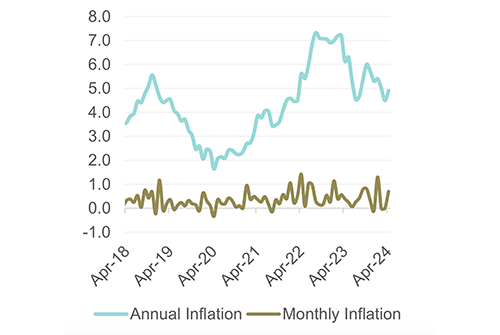The annual inflation rate for January 2022 increased to 4.6%, compared to 2.7% recorded in January 2021.
This is according to the latest monthly consumer price index for January 2022. Namibia Statistics Agency (NSA) CEO Alex Shimuafeni this week said this is the highest annual inflation rate recorded since February 2019. On a monthly basis, the inflation rate increased to 1.1%, compared to 0.4% registered in the prior month.
“The yearly inflation poses an increase of 1.9 percentage points. The main contributors to the annual inflation rate for January 2022 were transport (two percentage points); food and non-alcoholic beverages (one percentage point); alcoholic beverages & tobacco and furnishing, household equipment and routine maintenance of the house each contributed 0.5 percentage points; housing, water, electricity, gas and other fuels’ contribution stood at 0.3 percentages points; and recreation and culture; education and hotels, cafes and restaurant contributed 0.1 percentage points each,” he outlined.
In economics, inflation refers to a general progressive increase in prices of goods and services in an economy. When the general price level rises, each unit of currency buys fewer goods and services. Consequently, inflation corresponds to a reduction in the purchasing power of money. The opposite of inflation is deflation, a sustained decrease in the general price level of goods and services.
Meanwhile, the latest figures indicate that the transport category, which accounts for 14.3% of the consumer basket, continues to be the main driver of overall inflation, increasing by 13.5% in January 2022, compared to a decline of 0.8% recorded in January 2021.
“The increases in the transport component were reflected in the price levels of all sub-groups, with the exception of the purchase of vehicles, which slowed to 3.9% from 7.8% registered in January 2021. The monthly transport inflation rate slowed to zero percent in January 2022, compared to 2.1% recorded in December 2021,” explained Shimuafeni.
Furthermore, in January 2022, the annual inflation rates for goods increased by 5.8%, compared to 3.2% registered during the same period last year. The annual inflation rate for services rose by 3% in January 2022, compared to 2% recorded in January 2021.
According to the NSA CEO, the increase in the inflation rate for services emanated mainly from accommodation services (from -3.5% to 14.6%), the operation of personal transport equipment (from -4.7% to 19%), public transportation services (0.7% to 9.5%) and pre-primary education (from 0.4% to 4.4%).
The zonal inflation rates for the month of January 2022 revealed that zone two (Khomas) recorded the highest annual inflation rate of 5.3%, followed by zone three (Hardap, Omaheke, //Karas and Erongo), which recorded an annual inflation rate of 4.4%, and zone 1 (Kavango East, Kavango West, Kunene, Ohangwena, Omusati, Oshana, Oshikoto, Otjozondjupa and Zambezi), which recorded the least annual inflation rate of 4.1%.


